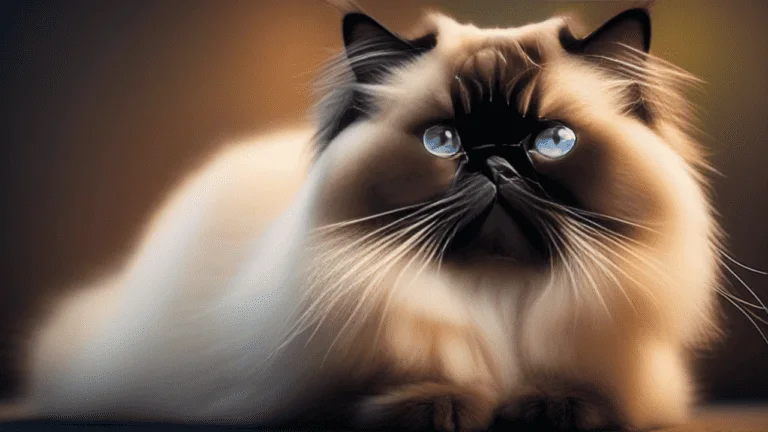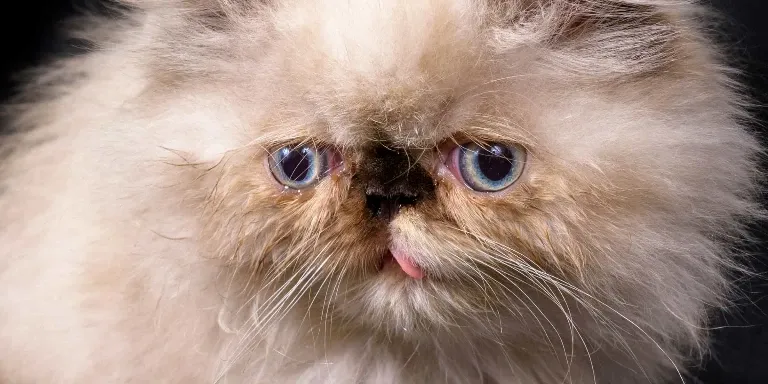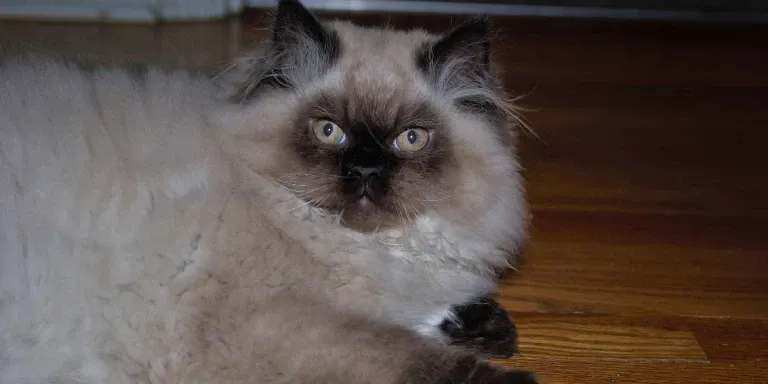The Best Fluffy Pancakes recipe you will fall in love with. Full of tips and tricks to help you make the best pancakes.

Do you have a Himalayan cat and wonder if they prefer to be alone? Understanding cat social behavior is crucial in providing the best care for your feline friend.
Himalayan cats, like most cats, are independent animals that enjoy alone time. However, they also enjoy spending time with their owners and can become lonely if left alone for extended periods. It is important to provide them with stimulation and attention to prevent loneliness.
While cats are often considered solitary animals, they still have a social nature that can affect their happiness and well-being. In this article, we will explore the social behavior of Himalayan cats and their personality traits, as well as provide tips for socializing and addressing any social issues that may arise.
Himalayan cats are known for their luxurious, long fur and striking blue eyes. They are also known for their affectionate and playful personalities, making them a popular choice for pet owners. However, it’s important to remember that each cat is unique and may have their own preferences when it comes to social interaction.
By understanding your Himalayan cat’s social behavior, you can create an environment that promotes their happiness and allows them to thrive. So, let’s dive into the world of Himalayan cats and their social needs.
Understanding Cat Social Behavior
Cats, including Himalayan cats, are social creatures and crave interaction with their owners and other cats. They may not be as social as dogs, but they still need to communicate with others.
Cat communication is complex, and it involves more than just meowing. Feline body language is also a significant part of their communication. For instance, a twitching tail or flattened ears can indicate that a cat is feeling agitated or anxious.
Understanding your Himalayan cat’s body language can help you determine what they need. If they seem to be hiding or avoiding you, it may be because they are anxious or scared. On the other hand, if they are rubbing against your leg or purring, they are probably seeking your attention.
Spending quality time with your Himalayan cat can help strengthen your bond and improve their overall happiness. So, even though they may be independent creatures, they still require social interaction to thrive.
Types of Social Behavior
When it comes to understanding cat social behavior, it’s important to know that there are three main types of cats:
- Solitary cats prefer to be alone and tend to avoid social interactions.
- Social cats thrive on social interaction and enjoy being around other cats and humans.
- In-between cats fall somewhere in between these two extremes, enjoying some social interaction but also needing their alone time.
Solitary Cats
Solitary felines, like the Himalayan cat breed, may prefer to have some alone time to recharge their energy. These cats have independent personalities and are known to be self-sufficient. They are content to spend hours lounging around, observing their surroundings, and enjoying their own company.
If you’re considering adopting a Himalayan cat, it’s important to understand that they may not be as social as other cat breeds. Here are a few things to keep in mind:
- Solitary cats may not enjoy being held or cuddled for long periods of time.
- They may prefer to have their own space and may not want to share it with other pets.
- These cats still need regular play and exercise to maintain their physical and mental health.
- Providing them with plenty of toys and activities to stimulate their minds can help prevent them from becoming bored or destructive.
Overall, if you’re looking for a low-maintenance cat that enjoys their alone time, a Himalayan cat may be the perfect fit for you. Just be sure to provide them with plenty of love and attention when they do seek it out.
Social Cats
If you’re looking for a feline companion that craves attention and loves to be in the spotlight, social cats are the way to go. These cats thrive on interaction and are known to be quite vocal when they want your attention. They enjoy being around people and other animals, and are often very affectionate towards their owners.
Cat socialization is an important aspect of feline companionship, and social cats are a great example of this. They require a lot of attention and stimulation, so if you’re someone who’s home often and enjoys spending time with your pet, a social cat may be the perfect match for you.
These cats tend to be more active and playful, and enjoy having a variety of toys and activities to keep them entertained. Overall, if you’re looking for a cat that will be a loyal and loving companion, a social cat may be just what you need.
In-between Cats
In-between cats are a great option for those who want a feline companion that isn’t too clingy but still enjoys some attention. These kitties aren’t as independent as some breeds, but they aren’t as social as others either. They’re perfect for those who want a cat that’ll be happy to curl up on your lap for some cuddles but won’t mind if you need to leave for a few hours.
If you’re considering an in-between cat as a companion, here are a few things to keep in mind:
- They enjoy feline companionship but don’t need constant attention from humans.
- They’re not as social as some breeds but still need some cat socialization.
- They may be more active than some breeds but don’t require as much exercise as others.
- They’re generally low-maintenance and easy to care for.
- They’re perfect for those who want a cat that offers the best of both worlds: independence and companionship.
Overall, in-between cats make wonderful companions for those who want a feline friend that isn’t too clingy but still enjoys some attention. They’re social enough to enjoy the company of humans and other cats but independent enough to be left alone for a few hours. With proper cat socialization and care, an in-between cat can be a loving and low-maintenance addition to any household.
Himalayan Cat Personality Traits
You’ll find that Himalayan cats have an affectionate personality that will warm your heart. These cats are known to be mellow, calm, and very social. They enjoy spending time with their owners, cuddling up on laps, and receiving plenty of attention. As a Himalayan cat owner, you’ll quickly discover that your feline friend is always eager to be near you.
Himalayan cats are also known for their grooming habits. These cats have long, luxurious coats that require regular brushing and combing. They enjoy being pampered and will often purr contentedly as you groom them.
In terms of playtime preferences, Himalayan cats enjoy interactive toys that stimulate their minds and keep them engaged. Overall, Himalayan cats are not loners and thrive in homes where they receive plenty of love and attention.
Socializing Himalayan Cats
To ensure that your Himalayan cat is sociable and friendly, it’s important to start socializing them from a young age. Himalayan cats thrive on socialization and bonding with their human companions. They are affectionate cats that enjoy spending time with their owners and playing together.
One way to socialize your Himalayan cat is through playtime activities. These can range from interactive toys to games that involve chasing and catching objects. Engaging in these activities with your cat allows them to develop their physical abilities and bond with you at the same time.
Another effective technique for bonding with your Himalayan cat is through grooming sessions. Regular brushing and petting can help build trust and strengthen your bond with your furry friend.
Additionally, providing your cat with a comfortable living space and plenty of attention will help them feel secure and happy in their environment.
Signs of Social Discomfort
If your Himalayan cat is feeling socially uncomfortable, they may exhibit certain behaviors that can give you an idea of their discomfort.
One of the most common signs is hiding. Your cat may retreat to a small, dark space, such as under the bed or behind furniture.
Avoiding eye contact is another tell-tale sign of social discomfort. If your cat is feeling uneasy, they may refuse to look directly at you or other people.
Additionally, your cat may hiss or growl at you or others, which is a sign that they are feeling threatened or unsafe.
It’s important to pay attention to your cat’s body language and vocalizations to understand their social needs.
If your Himalayan cat is showing signs of discomfort, try to identify what may be causing the issue. Perhaps they are feeling overwhelmed by too much noise or activity in the household, or maybe they need more alone time.
Whatever the reason, it’s essential to address the issue and make changes to ensure your cat’s overall well-being. By understanding your cat’s social needs, you can help them feel safe, secure, and content in their home environment.
Addressing Social Issues
When addressing social issues with your feline companion, it’s important to observe their behavior and investigate the underlying cause to ensure their well-being. Mental health is just as important for cats as it is for humans.
If your Himalayan cat is exhibiting signs of social discomfort, such as hiding or avoiding contact with you or other pets, it’s important to take action. Community building is essential for cats, just as it is for humans. Cats thrive in environments where they have plenty of opportunities to socialize with other cats and humans.
To address social issues with your Himalayan cat, consider the following steps:
- Provide plenty of toys and stimulating activities to keep them engaged
- Introduce them to other cats in a controlled setting to build their confidence and social skills
- Consult with a veterinarian or animal behaviorist if your cat’s social issues persist.
By taking action, you can help your Himalayan cat thrive in a social and mentally healthy environment.
Can Himalayan Cats’ Shedding Habits Affect Their Desire for Solitude?
Himalayan cats shedding habits can indeed affect their desire for solitude. Excessive shedding might lead to discomfort, prompting them to seek more alone time. Regular grooming and a clean environment can help minimize shedding and promote a calmer, more contented feline friend.
Conclusion
Congratulations! You now have a better understanding of Himalayan cats and their social behavior.
While these fluffy felines may sometimes prefer to be alone, they are still social creatures that crave interaction and affection from their owners. By providing them with a stimulating environment and socializing them from a young age, you can ensure that your Himalayan cat is happy and well-adjusted.
However, if you notice any signs of social discomfort, such as aggression or hiding, it’s important to address the issue promptly.
With patience, understanding, and a little bit of effort, you can help your Himalayan cat thrive and become a beloved member of your family. So go ahead and give your furry friend a cuddle – they’ll love you for it!








